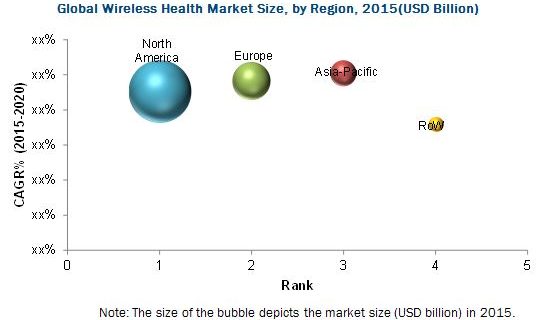
Growth in the overall market can largely be attributed to factors such as increasing advancements in wireless communication technologies, growing internet penetration, increasing utilization of connected devices in the management of chronic diseases, rising adoption of a patient-centric approach by healthcare providers, robust penetration of 3G and 4G networks in healthcare services, and mainstreaming of cloud computing.
The global wireless health market is projected to reach USD 110.12 Billion by 2020 from USD 39.03 Billion in 2015, at a CAGR of 23.1% during the forecast period of 2015 to 2020.
The market is expected to witness the highest growth in the Asia-Pacific region in the coming years. Growth in the Asia-Pacific region can be attributed to factors such as increasing population, growing internet penetration, rising medical tourism, increasing government initiatives for eHealth, and growing demand for quality healthcare.
The report segments the market of wireless health based on technologies, components, applications, end users, and regions. On the basis of technologies, the market is further segmented into WPAN, WLAN/WiFi, WiMAX, and WWAN. The WPAN technology market segment accounts for the largest share of the global market in 2015. The WPAN technology segment is further segmented into Bluetooth, RFID, Ant+, Zigbee, Z-wave, and UWB. The Bluetooth segment accounts for the largest share of the WPAN market in 2015. The large share of WPAN technologies can be attributed to the fact that these technologies are user friendly, secure, and affordable.
Download PDF Brochure: https://www.marketsandmarkets.com/pdfdownloadNew.asp?id=551
Global Wireless Health Market is Segmented on:
1. Technology
2. Component
3. Application
4. End User
On the basis of components, the market is segmented into hardware, software, and services. The software segment accounts for the largest share of the global market in 2015. Increasing adoption of healthcare IT solutions and growing need for upgrading the existing software are the major driving factors for the growth of this market.
On the basis of technology, the market of wireless health is further segmented into WPAN, WLAN/WiFi, WiMAX, and WWAN. The WPAN technology market segment accounts for the largest share in the market in 2015. WPAN technologies are highly secure and affordable, making them one of the most widely adopted wireless health technologies. The WPAN technology segment is further segmented into Bluetooth, RFID, Ant+, ZIgbee, Z-wave, and UWB.
On the basis of applications, the market of wireless health is further segmented into patient-specific applications and provider/payer-specific applications. Patient-specific applications account for a major share of the global market in 2015 due to increasing adoption of wireless devices and rising need for quality care.
Request Sample Pages: https://www.marketsandmarkets.com/requestsampleNew.asp?id=551
The geographical regions mapped in the report are:
The market is expected to witness the highest growth in the Asia-Pacific region in the coming years. Growth in the Asia-Pacific region can be attributed to factors such as increasing population, growing internet penetration, rising medical tourism, increasing government initiatives for eHealth, and growing demand for quality healthcare
Some key players mentioned in the research report are:
Prominent players in the Wireless Health Market include Allscripts Healthcare Solutions, Inc. (U.S.), AT &T, Inc. (U.S.), Cerner Corporation (U.S.), Omron Corporation (U.S.), Philips Healthcare (U.S.), Verizon Communications, Inc. (U.S.), Qualcomm, Inc. (U.S.), Aerohive Networks, Inc.(U.S.), Vocera Communications, Inc. (U.S.), and Alcatel-Lucent (U.S.) are some of the key players in the wireless health market worldwide.


